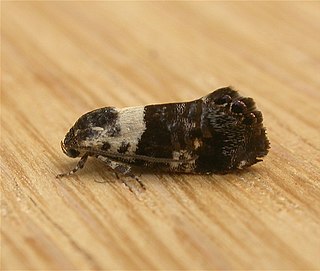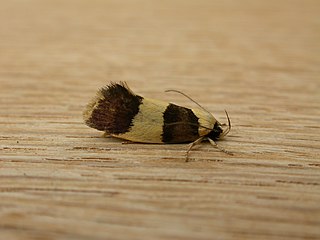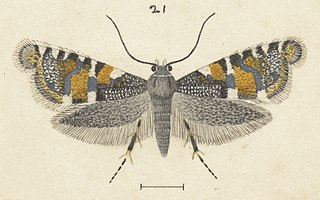
Eupselia aristonica is a species of moth of the family Depressariidae. It is found in Australia, where it has been recorded from New South Wales, the Australian Capital Territory, Victoria and Tasmania.
Trichoptilus scythrodes is a moth of the family Pterophoridae that can be found in Australia, including New South Wales and South Australia.

Sabatinca heighwayi is a species of moth belonging to the family Micropterigidae. It was described by Alfred Philpott in 1927 and is endemic to New Zealand. It can be found north of Lewis Pass in the north west of the South Island. Adult moths are on the wing from late September until the middle of January. The host of the larvae of this species is the foliose liverwort Plagiochila circumcincta.

Lichenaula lichenea is a species of moth of the family Xyloryctidae. It is known in Australia from the Australian Capital Territory, New South Wales and Queensland.

Telecrates laetiorella is a moth of the family Xyloryctidae. It is known from the Australian Capital Territory, New South Wales, Queensland, South Australia and Victoria.

Glyphipterix euastera is a species of sedge moth in the genus Glyphipterix. It is endemic to New Zealand. This species is classified as "At Risk, Naturally Uncommon" by the Department of Conservation.
Metasia strangalota is a moth in the family Crambidae. It was described by Edward Meyrick in 1887. It is found in Australia, where it has been recorded from New South Wales.

Nacoleia mesochlora is a moth in the family Crambidae. It was described by Edward Meyrick in 1884. It is found in Australia, where it has been recorded from Queensland, the Northern Territory, New South Wales, Victoria, South Australia and Western Australia.
Euchaetis endoleuca is a moth in the family Oecophoridae. It was described by Edward Meyrick in 1888. It is found in Australia, where it has been recorded from South Australia and Western Australia.
Homadaula lasiochroa is a moth in the family Galacticidae. It was described by Oswald Bertram Lower in 1899. It is found in Australia, where it has been recorded from New South Wales.
Ardozyga sarisias is a species of moth in the family Gelechiidae. It was described by Edward Meyrick in 1904. It is found in Australia, where it has been recorded from southern Queensland.
Stegasta cosmodes is a moth of the family Gelechiidae. It was described by Oswald Bertram Lower in 1899. It is found in Australia, where it has been recorded from New South Wales.
Dorycnopa heliochares is a moth of the family Gelechiidae. It was described by Oswald Bertram Lower in 1900. It is found in Australia, where it has been recorded from South Australia.
Dorycnopa orthodesma is a moth of the family Gelechiidae. It was described by Oswald Bertram Lower in 1901. It is found in Australia, where it has been recorded from New South Wales.
Catoryctis truncata is a moth in the family Xyloryctidae. It was described by Thomas Pennington Lucas in 1902. It is found in Australia, where it has been recorded from New South Wales and Queensland.
Cryptophasa tetrazona is a moth in the family Xyloryctidae. It was described by Oswald Bertram Lower in 1901. It is found in Australia, where it has been recorded from New South Wales, Queensland, Victoria and Western Australia.
Lichenaula arisema is a moth in the family Xyloryctidae. It was described by Edward Meyrick in 1890. It is found in Australia, where it has been recorded from New South Wales, South Australia and Victoria.
Eupselia theorella is a moth in the family Depressariidae. It was described by Edward Meyrick in 1880. It is found in Australia, where it has been recorded from New South Wales.
Agriophara hyalinota is a moth in the family Depressariidae. It was described by Oswald Bertram Lower in 1899. It is found in Australia, where it has been recorded from South Australia and Queensland.

Meterana badia is a species of moth in the family Noctuidae. This species is endemic to New Zealand.






